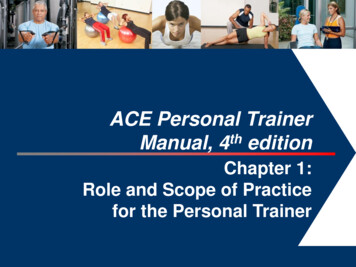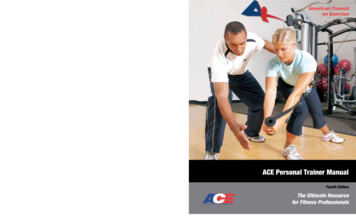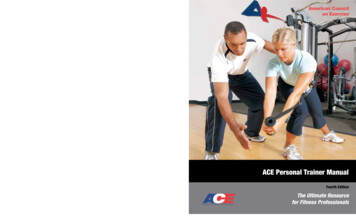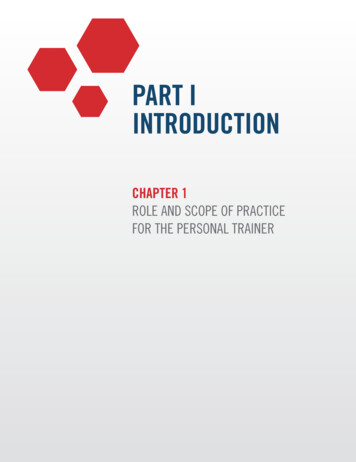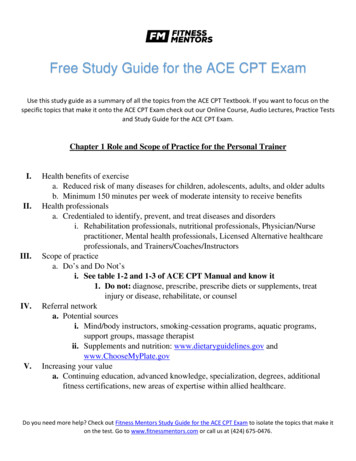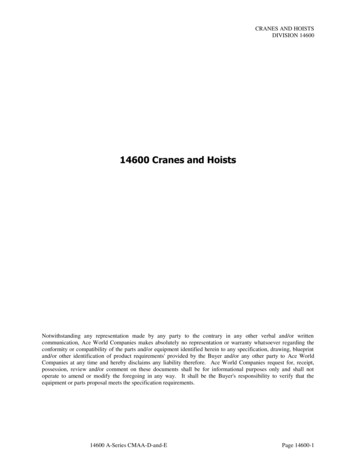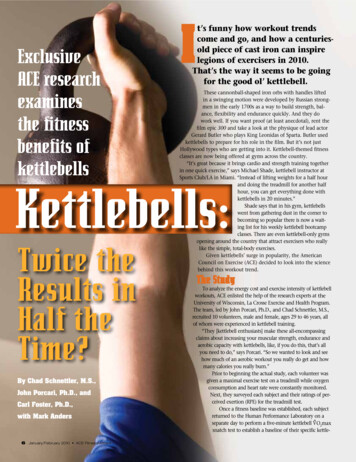
Transcription
ExclusiveACE researchexaminesthe fitnessbenefits ofkettlebellsIt’s funny how workout trendscome and go, and how a centuriesold piece of cast iron can inspirelegions of exercisers in 2010.That’s the way it seems to be goingfor the good ol’ kettlebell.These cannonball-shaped iron orbs with handles liftedin a swinging motion were developed by Russian strongmen in the early 1700s as a way to build strength, balance, flexibility and endurance quickly. And they dowork well. If you want proof (at least anecdotal), rent thefilm epic 300 and take a look at the physique of lead actorGerard Butler who plays King Leonidas of Sparta. Butler usedkettlebells to prepare for his role in the film. But it’s not justHollywood types who are getting into it. Kettlebell-themed fitnessclasses are now being offered at gyms across the country.“It’s great because it brings cardio and strength training togetherin one quick exercise,” says Michael Shade, kettlebell instructor atSports Club/LA in Miami. “Instead of lifting weights for a half hourand doing the treadmill for another halfhour, you can get everything done withkettlebells in 20 minutes.”Shade says that in his gym, kettlebellswent from gathering dust in the corner tobecoming so popular there is now a waiting list for his weekly kettlebell bootcampclasses. There are even kettlebell-only gymsopening around the country that attract exercisers who reallylike the simple, total-body exercises.Given kettlebells’ surge in popularity, the AmericanCouncil on Exercise (ACE) decided to look into the sciencebehind this workout trend.Kettlebells:Twice theResults inHalf theTime?By Chad Schnettler, M.S.,John Porcari, Ph.D., andCarl Foster, Ph.D.,with Mark Anders6 January/February 2010 ACE FitnessMattersThe StudyTo analyze the energy cost and exercise intensity of kettlebellworkouts, ACE enlisted the help of the research experts at theUniversity of Wisconsin, La Crosse Exercise and Health Program.The team, led by John Porcari, Ph.D., and Chad Schnettler, M.S.,recruited 10 volunteers, male and female, ages 29 to 46 years, allof whom were experienced in kettlebell training.“They [kettlebell enthusiasts] make these all-encompassingclaims about increasing your muscular strength, endurance andaerobic capacity with kettlebells, like, if you do this, that’s allyou need to do,” says Porcari. “So we wanted to look and seehow much of an aerobic workout you really do get and howmany calories you really burn.”Prior to beginning the actual study, each volunteer wasgiven a maximal exercise test on a treadmill while oxygenconsumption and heart rate were constantly monitored.Next, they surveyed each subject and their ratings of perceived exertion (RPE) for the treadmill test.Once a fitness baseline was established, each subjectreturned to the Human Performance Laboratory on a separate day to perform a five-minute kettlebell VO2maxsnatch test to establish a baseline of their specific kettle-
bell fitness. For this test, the subjects used a 12-, 16-, or 20-kilogram kettlebell (depending on their gender, body weight, fitnesslevel, and experience level) swinging it one-handed between theirlegs and up and over the head in a snatch motion. The subjectscontinuously performed snatches to a specific cadence duringeach minute, switching to the opposite hand for the snatch everyother minute.The maximal kettlebell test format went like this: First minute: 8 repetitions at a rate of 1 snatchevery 7 seconds Second minute: 12 repetitions at a rate of 1 snatchevery 5 seconds Third minute: 15 repetitions at a rate of 1 snatchevery 4 seconds Fourth minute: 20 repetitions at a rate of 1 snatchevery 3 seconds Fifth minute: The subject went all out, performingas many snatches as they could until fatigue. Meanwhile, heart rate (HR) and oxygen consumption (VO2)were measured during each stage. A peak RPE was taken followingthe test as well as blood lactate levels, which were tested using thefinger prick method three minutes after completion of the test.The number of snatches each subject successfully completedduring the final minute of the test determined the number ofsnatches they would be asked to perform during the actual kettlebell testing (to be conducted on a separate day). For example, ifa subject completed 24 snatches during the final minute, thisnumber was divided by four and they were required to completeat least six snatches during each timed 15-second period of the20-minute kettlebell snatch workout.After both the maximal exercise and maximal kettlebell testshad been completed, each subject then performed a pre-determined 20-minute kettlebell snatch workout typical of a commonkettlebell routine. Following a basic warm-up, subjects did 15 seconds of one-armed snatches, first with their dominant hand, thenafter a 15-second rest period, they performed another 15 secondsof snatches with the other hand. The workout continued likethat, with intervals of 15 seconds of work and 15 seconds of rest,for 20 minutes, followed by a five-minute cool-down.Throughout the workout, researchers monitored each subject’sHR at 60-second intervals, followed by a blood lactate test whichwas taken immediately following completion of the workout.The ResultsDuring the 20-minute workout, the average calorie burn was272 calories, not counting additional calorie burn due to the substantial anaerobic effort.“We estimated oxygen consumption and how many caloriesthey were burning aerobically, and it was 13.6 calories per minute.But we also measured the blood lactate, so anaerobically they wereburning another 6.6 calories per minute,” explains Porcari. “Sothey were burning at least 20.2 calories per minute, which is offthe charts. That’s equivalent to running a 6-minute mile pace. Theonly other thing I could find that burns that many calories is crosscountry skiing up hill at a fast pace.”Researchers credit the brisk calorie burning to the fact that thekettlebell snatch workout is a total-body movement that is also donevery quickly due to the interval-training format. “We knew it wouldbe extremely intense,” says Schnettler. “It’s a quick workout, andyou do get a big bang for your buck in a very short amount of time.”Continued on page 16Table 1 Average HR, VO2 , RPE and Caloric ExpenditureValues for the Kettlebell Workout*Mean RangeHR (bpm)SD164 14.7% HRmax93 4.586 – 9931.6 3.7124.6 – 36.678 8.067 – 9113.6 3.088.75 – 17.8515.9 2.2110 – 18 V O2 (ml/kg/min) % V O2maxKcal/minRPE128 – 180 *All HR and V O2 values are compared to maximal values measuredduring the kettlebell snatch test.Figure 1Average HR During Kettlebell WorkoutThis studywas fundedsolely by theAmericanCouncil onExercise.175—170—HR — 1 2 3 4 5 6 7 8 9 10 11 12 13 14 15 16 17 18 19 20Time (minutes)Kettlebellexercisesbegin onpage 8ACE FitnessMatters January/February 2010This study was funded solely by the American Council on Exercise.7
Ring in the New Year with KettlebellsKick start your get fit resolution with a centuries-old workout revved up for2010 by ACE exercise physiologist Fabio ComanaAs our ACE-sponsored research demonstrates, kettlebells canoffer a highly effective workout. In addition to boostingyour strength and cardiovascular fitness, it is likely you’ll alsoincrease your balance and flexibility, too. And since kettlebelltraining is so efficient, you may be able to get better results whilespending less time in the gym.We tapped Fabio Comana, M.A., M.S., one of ACE’s residentexercise physiologists, to design the following total-body kettlebellworkout and six-week training regimen. While traditional kettlebelltraining calls for 18-pound kettlebells for women and 35-poundkettlebells for men, it’s a better idea to choose a lighter weight andfocus instead on developing correct technique. For women, kettlebells weighing 8 to 15 pounds would be a good place to start. Menmay want to go with 15- to 25-pound kettlebells. As you becomestronger and more skilled, add reps and shorten your recovery timebetween sets. If you still need a greater challenge, only then shouldyou increase the weight of the kettlebell you’re using.Aim to do this kettlebell routine at least two to three times a week,performing each of the exercises in the order shown below. For amore detailed progression, see Comana’s Six-Week Training Plan.As always, warm up before working out andcool down and stretch afterward as needed.1. Kettlebell Deadlift (targets glutes, quads, back) Stand with feet hip-width apart, arms at your sides, andplace a kettlebell adjacent to each foot. Firmly grasp the kettlebell in each hand, pausingmomentarily to check your body alignment. Engage your core and abdominal muscles (“bracing”)to stabilize your lower back and maintain thiscontraction throughout the exercise while breathingnormally. Your heels should be in contact with the floor and remain incontact with the floor throughout the exercise. Depress your shoulders and squeeze your shoulderblades together (“setting your shoulders”) andmaintain this position throughout the exercise. Initiate your downward movement by pushing yourhips backward (“hip hinging”) before lowering yourbody toward the floor. Avoid allowing your knees to travel forward to initiateyour downward movement. Your tibia (shin bone) and torso should be parallel to eachother, with your shoulders positioned directly over thekettlebells or slightly in front of them. Maintain your “bracing” and “shoulder setposition,” exhale while firmly grasping eachkettlebell, raising your body until you returnto a full standing position. Inhale and slowly return to the lowered position. Complete the recommended number ofrepetitions.2. Kettlebell Single-Arm Swing(targets glutes, quads) Stand with feet hip-width apart, and place a kettlebell between your feet. Set your shoulders and brace, maintaining these contractions throughoutthe exercise. Hip hinge to lower your body down to grasp the kettlebellwith one arm. Exhale, initiating an explosive upward movement to swingthe kettlebell upward, returning to a vertical standing position(do not swing your torso beyond vertical). The momentum gathered through the lower extremityshould allow the kettlebell to swing until the arm isparallel to the floor. Maintain alignment through thewrists, preventing them from flexing or extending pastthe parallel arm-position. Remember that this is not a shoulder exercise, but an exerciseto generate explosive forces in the hips. If you are unable toachieve the desired arm position, attempt to thrust harderwith your glutes from the lowered position. Complete the recommended number of repetitions and thenrepeat with the opposite arm.8 January/February 2010 ACE FitnessMattersThe number of reps andcircuits listed are justa recommendation. It’simportant that you selectan intensity (number ofreps and circuits) thatallows you to challengeyour body, yet stillcomplete all the repswithout compromisingyour exercise techniqueor body alignment.WEEDo osix toper e30-seery bexercdo thminimtimes
3. Turkish Half Get-up (targets abs, core, shoulders) Lie flat on the floor with your right leg in a bent-knee position and akettlebell placed close to your right shoulder. Using both arms if necessary, pick up the kettlebell and rest it against theback of your right forearm while maintaining a neutral wrist. Extend your right arm out to the side and rest it on the floor. Set your right shoulder, slowly exhale and then gently press the kettlebellupward, extending the elbow while maintaining a neutral wrist position. Begin the half get-up by exhaling, contracting your abdominals, and pushing off your left arm to curlyour trunk upward to a vertical position while keeping the kettlebell pressed overhead. Hold this position briefly before slowly uncurling your trunk and lowering yourself back to the floor,using your left arm for support. Complete the recommended number of repetitions and then repeat with the opposite arm.4. Kettlebell Push-up (targets chest, triceps, core) Grasp the handle of each kettlebell and assume a full or bent-kneepush-up position. Maintain neutral wrists throughout the exercise. Brace to stabilize the trunk, and maintain a stiff, rigid trunkthroughout the exercise. Inhale and slowly lower your body toward the floor to a levelwhere the chest is aligned with your hands. Exhale and slowly press your torso upward. Complete the recommended number of repetitions.EK 1:one circuit ofo eight repsexercise with aecond recovbetween eachcise. Aim tohis workout amum of twos this week.5. Kettlebell Single-arm Row (from push-up position)(targets back, biceps, core) Assume the starting push-up position, but place one kettlebell beneath the left shoulder. Open up your stance, widening your feet to help stabilize your body. Brace to stabilize your trunk, and maintain a stiff, rigid trunk throughout theexercise. Grasp the kettlebell in the left hand, exhale and slowly perform a rowmovement, lifting the kettlebell toward your left shoulder, holding it in theraised position briefly before lowering it back toward the floor. Attempt to prevent any rotation of your torso throughout the movement. Complete the recommended number of repetitions and then repeat with theopposite arm.Six-week Training PlanWEEK 2:Do one circuit of10 to 12 reps perexercise with a30-second recovery between eachexercise. Aim todo this workout aminimum of twotimes this week.WEEK 3:Do two circuitsof eight reps perexercise with a30-second recovery between eachexercise. Aim todo this workout aminimum of twotimes this week.WEEK 4:Do two circuitsof 12 reps perexercise with a30-second recovery between eachexercise. Aim todo this workout aminimum of threetimes this week.WEEK 5:Do three circuitsof 10 reps perexercise with a30-second recovery between eachexercise. Aim todo this workout aminimum of threetimes this week.WEEK 6:Do three circuitsof 15 reps perexercise with a30-second recovery between eachexercise. Aim todo this workout aminimum of threetimes this week.Moreexerciseson page 10ACE FitnessMatters January/February 20109
6. Kettlebell Walking Lunge(targets quads, hamstrings) Stand with both feet together while holding akettlebell at chest height, close to your body. Slowly perform a series of lunges while holding thekettlebell close to your chest. When lunging, attempt to “hip-hinge” to initiatethe lunge movement (when your lead foot touchesthe floor) and avoid driving your knee forward tooprematurely. Complete the recommended number of repetitionsand then repeat with the opposite arm.7. Kettlebell Shoulder Press(targets shoulders, triceps) Stand with both feet together while holding akettlebell in your right hand. Set your shoulders and brace, maintaining thesecontractions throughout the exercise. Pull the kettlebell upward to assume the startingposition as illustrated. The forearm should bepositioned vertically, slightly inside the hips, withthe kettlebell resting against the back of theforearm and wrist in a neutral position. [Note: Dueto possible breast interference that may preventone from positioning the elbow inside of the hips,some women may need to shift their hips outwardto the same side (a).]a. Exhale and slowly press the kettlebell upward,maintaining a neutral wrist position. Some individuals may favor using both armsto press the kettlebell upward. Grasp the rightforearm with your left arm and press the kettlebelloverhead (b). Complete the recommended number of repetitionsand then repeat with the opposite arm.b.8. Kettlebell Halo(targets core) Stand with feet hip-width apart and hold a kettlebellin both hands. Set your shoulders and brace, maintaining thesecontractions throughout the exercise. Exhale and slowly raise the kettlebell above yourhead (bent-elbow position) as illustrated. Perform slow circles around the head (“halo”),keeping he wrist neutral and elbows bent. Complete the recommended number of repetitionsand then repeat in the opposite direction.10 January/February 2010 ACE FitnessMatters
KettlebellsContinued from page 7As for heart-rate data, the average HR during thekettlebell snatch workout was between 86 percent and99 percent of the kettlebell HR max for all subjects(Figure 1). “The average heart rate was 93 [percent], butsome people averaged, for the 20-minute workout,99 percent of heart rate max,” says Porcari. “Anytimeyou’re using that much muscle effort, it’s going to be avigorous workout.” As for the VO2max, the treadmill VO2max was23 percent higher (38.9 ml/kg/min vs. 31.6 ml/kg/min) than the VO2max attained during the kettlebell VO2maxtest (Table 1).4851 Paramount DriveSan Diego, CA 92123The Bottom LineKettlebells can provide one heck of a workout. Based oncomparisons with data from previous research on standard weight training, the HR and VO2 responses during thekettlebell snatch routine suggest it provides a muchhigher-intensity workout than standard weight-trainingroutines. Furthermore, the kettlebell snatch workouteasily meets industry recommendations for improvingaerobic capacity. “This is good news for people who arelooking for a very good resistance-training workout thatwill also help them lose weight,” says Schnettler. “Forpeople who might not have a lot of time, and need toget in a good workout as quickly as possible, kettlebellsdefinitely provide that.”www.acefitness.org/getfitYour trusted online source for safe and reliable fitnessinformation from the American Council on Exercise (ACE ).Visit the new GetFit section of the ACE website for FREEinformation and tools to keep you active and healthy. Exercise Library Workouts Fitness Product Reviews Tools & Calculators Ask the Expert Blog Healthy Recipes Fit Facts Research & StudiesLeave your comments, rate exercises and workouts, provide feedback on fitness productsand more! Visit www.acefitness.org/getfit today, and check back often as new content isadded weekly.P10-020
kettlebell snatch workout is a total-body movement that is also done very quickly due to the interval-training format. “We knew it would be extremely intense,” says Schnettler. “It’s a quick workout, and you do get a big bang for your buck in a very short amount of time.” Kettle
